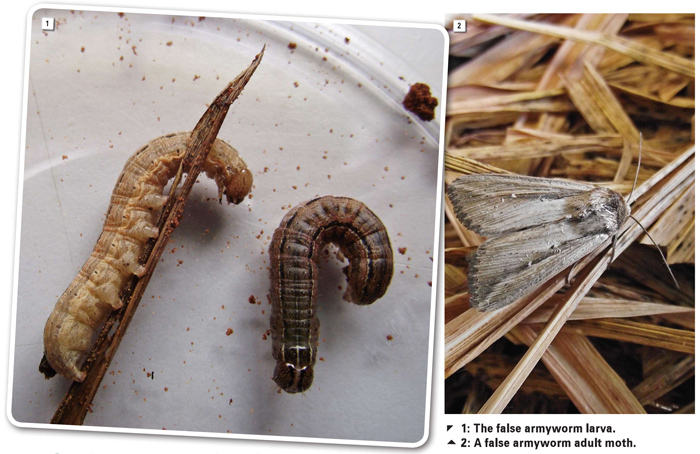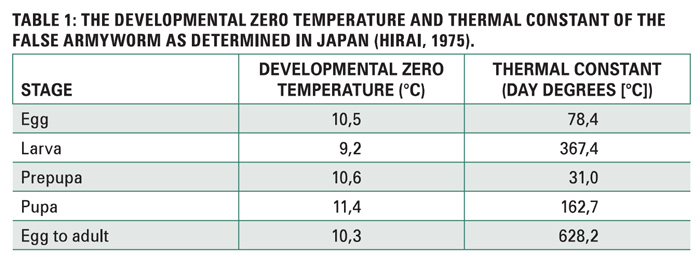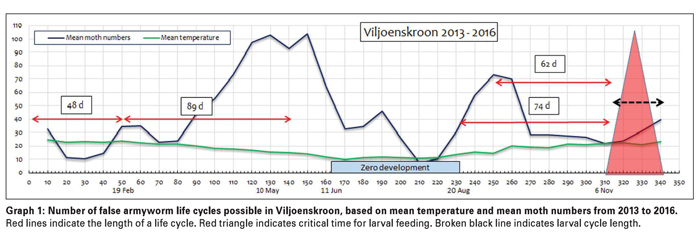September 2018
The false armyworm, Leucania loreyi, is a cosmopolitan pest that has been known in South Africa for years, causing minor damage to maize and grain sorghum (Photo 1 and Photo 2). However, during November 2010, a sudden outbreak occurred on wheat and barley produced under irrigation in the Vaalharts and Douglas areas, with at least R8,5 m damage caused on just more than 2 000 ha.

At the same time, larvae also caused damage to wheat in the Sand-Vet and Viljoenskroon irrigation areas. Following this outbreak, producers in all the areas have become very cautious about the pest and regularly administer preventative insecticide applications during October.
A project was initiated to monitor and map the seasonal occurrence of false armyworm in the Northern Cape irrigation areas for the establishment of an early warning system for the producers. This project was conducted in collaboration with North-West University and GWK.
Trapping sites were established at Douglas, Bull Hill, Vaalharts experimental farm, Hartswater and Viljoenskroon. Bucket funnel traps were used from 2013 to December 2016 and traps were emptied once every fortnight and the moth numbers recorded.
Later, all data were converted to ten day intervals to compare between years. The presence of feeding signs and larvae was also monitored through annual surveys during October. Moth numbers, together with information on the presence of feeding signs and larvae, were used to warn producers when necessary through radio talks, the popular media and personal communication.
Climate data were recorded using onsite data recorders, but were also obtained from ARC-Soil Climate and Water.
Connection between climate and moth numbers
All insects are cold-blooded and temperature therefore governs the speed of their development. Each insect has a lower and a higher temperature threshold outside of which no development will occur. The lower temperature threshold is used to calculate the number of day degrees (heat units) for insect development per day, by subtracting the lower temperature threshold from the mean daily temperature.
 Each insect needs a certain quantity of day degrees to complete each stage as well as its total life cycle. This parameter is specific for an insect species and can be determined in the laboratory to predict when the insects will be present in the field and when possible outbreaks may occur.
Each insect needs a certain quantity of day degrees to complete each stage as well as its total life cycle. This parameter is specific for an insect species and can be determined in the laboratory to predict when the insects will be present in the field and when possible outbreaks may occur.
False armyworm developmental rates were determined during the mid-seventies in Japan. Since this information is lacking in South Africa, we decided to test how the Japan information (Table 1) would fit on the moth flight and temperature data collected between 2013 and 2016.
From this table it is clear that to complete the life cycle from egg to adult we need 628,2 day °C above its lower temperature threshold of 10,3°C. The larval stage needs 367,4 day °C above its 9,2°C threshold to be completed.
For the best overall picture, the four year mean for moth numbers and temperatures was calculated for each trap site. Viljoenskroon data will be used as an example.
Viljoenskroon
Five moth peaks are present throughout the year (Graph 1). A moth life cycle was predicted to start and end with a moth flight peak. According to the calculations of accumulated day degrees from the beginning of the year, the first life cycle was completed within 48 days, which coincides perfectly with the cycle on the graph. 
The second life cycle was calculated to be 89 days, which also coincides with the second cycle on the graph. The temperature threshold and thermal constant data that were generated in Japan thus seem similar to that in South Africa and can give a good indication of what probably happens under South African conditions.
Between 11 June and 20 August, the mean daily temperature drops to below 10°C and development will stop (Graph 1). Though moth flight activity is found during this period, it is not clear if eggs laid during this period will be able to survive and develop into larvae.
Eggs laid during September (240 days - 250 days) will complete the life cycle at 310 days, which is the beginning of November. Surveys were conducted early in October (260 days - 280 days) and feeding signs as well as larvae were found.
As these observations were made during the middle of the predicted life cycle, it suggests that the prediction could fit. From 310 days, eggs will hatch within six days rendering larvae ready to feed on the ripening barley and wheat crop (Graph 1).
Help predict outbreaks
This model provides better insight into what happened during 2010. We have developed a spreadsheet model, which is easy to use, but this should be validated under field conditions first, before producers can use it. Producers will soon be able to use their own trap and temperature data logger to determine a possible outbreak situation.
When high moth numbers occur, specifically during September, the probability is strong that high numbers could be present at the end of the barley-growing season.
However, sudden cold fronts could delay the development of the insect and prevent an outbreak during the critical time. Validation will be performed during the next three years, after which it will be made available to the producers.
For any enquiries contact the author at prinsloogj@arc.agric.za.
 Reference
Reference
Hirai, K. 1975. The influence of rearing temperature and density on the development of two Leucania species, L. loreyi Dup. and L. separata. Walker (Lepidoptera: Noctuidae).

Publication: September 2018
Section: Focus on integrated pest control